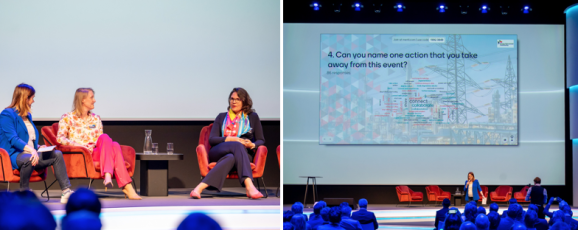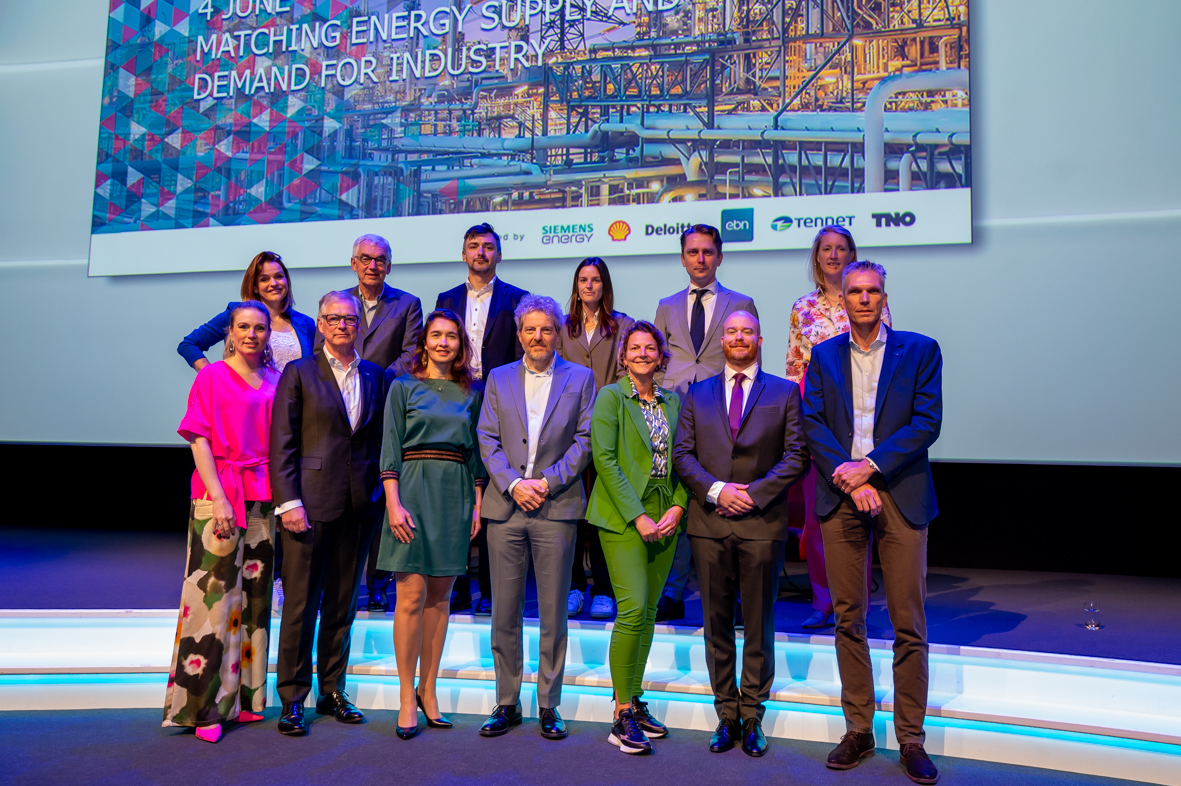
REPORT EVENT 4 JUNE
This week Dutch Parliament adopted the new Energy Act proposed by outgoing minister Rob Jetten. It also became clear that the anticipated cabinet intends to stick to the climate goals. In the same week ERC focused on the future of industry with the event MATCHING ENERGY SUPPLY AND DEMAND FOR INDUSTRY hosted by Siemens Energy and TenneT at NBC Nieuwegein.
This political context provides the important background for the industry in the Netherlands and neighbouring countries. To meet the climate goals industry needs to reduce its emissions and in order to prepare for a more sustainable and circular future. This brings about an even larger challenge to start making products using renewable carbon, hydrogen and renewable energy as inputs and circular products as output. And all of this in a Europe that can compete with the rest of the world. We discussed the formidable challenges and promising opportunities with over 200 participants.
Carina Krastel Hoek, Director Business Guidance at TenneT and Maxim Zubov, Vice-President Turkey, Central Asia and Western Europe at Siemens Energy opened the event on behalf of the hosting ERC partners.

Gert-Jan Kramer, Professor of Sustainable Energy Supply Systems University Utrecht kicked off the programme and shared insights from research he did with the Sustainable Industry Lab. According to Kramer the Dutch industry portfolio can be transformed to both carbon-neutral and circular, but this would require more offshore wind capacity using the resources of the North Sea to produce renewable offshore energy – both for electricity and green hydrogen. Kramer also highlighter the relevance of circular economy regulations for e.g. biomass & waste for chemical feedstock and bunker fuels. “The future of industry is a societal choice,” said Kramer. “This calls for shared vision for the long term and a realistic view, including the cooperation cross border with neighbour our countries of the short and mid-term. The choice to retain industry is dependent on governments supporting this.”
Industry clusters
One way that government supports the future of industry is by its cluster approach. Anne-Marie Spierings, Economic Transition Program Director at Deltalinqs and Chair of the Rotterdam-Moerdijk cluster and Barbara Huneman, Owner PowerBy BV and Chair Cluster 6 shared their experiences with the cluster approach. While the industries and companies they represent differ greatly, the challenges and possible solutions are similar. One challenge they see is how to bridge the time gap between the investment plans from companies to electrify and the investment plans of network companies. “80% of investments in sustainability will not be executed before 2030”, said Huneman based on Cluster 6 research. Spierings sees companies making the choice to leave The Netherlands. “But the stage before that remains invisible,” says Spierings. “Companies make a choice to produce less. This may have the benefit of emissions reductions, but that is not the consequence of efficiency or electrification.” Both chairs spend a lot of time in making connections between stakeholders that do not necessarily speak each other’s language. Working with factories and network operators for example, about practical solutions in demand flexibility. There is a willingness among factories, but they need to understand how this can work.

Cross-border
The cluster approach takes place within the Dutch borders. But many companies operate internationally or even in cross-border projects. For Jurgen Hoekstra, Vice President & Managing Director at BASF, it is therefore clear that we cannot only look at The Netherlands and in fact should pay a lot more attention to cross-border collaboration between The Netherlands, Germany and Belgium. “The Delta Rhine Corridor is a good example. We want to build the infrastructure and push the market.” Still, political attention for industry is welcome. Nienke Homan, President, The Royal Association of the Dutch Chemical Industry (VNCI) mentions the Antwerp Declaration for a European Industrial Deal. Hoekstra confirms “The Antwerp Declaration is a very good first step with clear goals. Now it’s important that we connect goals with consistent policy to get there.”
Funding
Another requirement to build new infrastructure or make changes to an asset is capital. Steef Thomassen, Senior Loan Officer at the European Investment Bank, gave examples of how the European Investment bank offers financing solutions for renewable energy projects but also for green industrial production, battery storage and sustainable aviation fuels. One project is a green steel project using green hydrogen in Sweden. EIB is the largest financier for climate impact lending solutions and lends around EUR 65bn a year. The EIB can offer a range of financing options ranging from specific project financing solutions to early-stage venture debt and corporate loans. Numbers range from 5 million euro lent to a start-up to multi-billion loans to multiparty projects. “What is important for EIB to become involved, is that a company has already talked to a bank and involved consultants. We don’t offer funding, we finance, and never alone”, Thomassen said.

Derisking
Next on the agenda was a panel discussion with Tessa Hermens of NVDE, Hans Grünfeld of Royal VEMW, Henk Leendertse of Nyrstar, Karlo van Dam of the Dutch Ministry of Economic Affairs and Climate Policy and Cato Kannekens, Shell. Investments came up during the panel as well. Who should bear upfront investments costs in network connection for example. And how to derisk investments in new projects. Tessa Hermens, Programme Lead Sustainable Industry, NVDE, thinks we need to look at risks in the full value chain of matching energy demand and supply infrastructure. “On the supply side companies are looking at what two-sided Contracts for Difference can do to derisk investments.” This would mean that on the lower end there is a limit in the amount of subsidies and on the upper end there is a limit on profits. “Such a mechanism could be interesting for the demand side, for industry, too, to derisk investments in the entire value chain.”
Until that time and to help balance the grid Nyrstar is looking at other solutions. Henk Leendertse, General Manager, Nyrstar Budel shared how Nyrstar is working together with other companies to see if they can free up power through a so-called “non-firm ATO”. “We are ready to take a calculated risk in order to make room for others.” ACM is working on making the regulatory changes so network operators can offer attractive tariffs to companies that can apply flexibility to their use of the grid.
Uncertainty about demand for network companies and uncertainty about available grid connections constitutes the largest chicken-and-egg dilemma. Karlo van Dam, Director Sustainable Industry at the Dutch Ministry of Economic Affairs and Climate Policy confirmed the important role of the industrial clusters in understanding demand in the Netherlands and our neighbour countries. He added that his ministry is actively supporting infrastructure to be built ahead of demand, the hydrogen backbone is a main example or offshore wind farms. But ultimately it is the TSO and DSO that have their own role and mandate.

Long term
The morning session ended with a double interview with Margriet Rouhof, Head of Strategy, TenneT and Carina Brehm, VP Strategy, Siemens Energy. Rouhof showed a picture of TenneT’s target grid for 2045, showing a lot of plans for the North Sea. “It’s important to think about timing.” Rouhof stated. “We need to be predictable, not only to customers but also towards suppliers.” By setting a number of fixed variables, TenneT can better prepare. For Brehm the picture and message are very recognizable. “Project timelines take at least ten years. We are preparing for a hybrid energy system and with a horizon of 2045 you need to start now.” Responding to the question what the one thing is that participants need to remember Rouhof responds: “We need to talk each other’s language to understand each other.” Brehm adds: “And please stop talking about winners and losers in the European context. Energy transition is not about 27 silos, it’s about EU wide collaboration.”
Collaboration and co-creation
The spirit of collaboration was present in the room. This became tangibly visible at the end of the day through the plenary creation of a word cloud, in response to the question “Can you name one action that you take away from this event?” Responses included “Stop talking, start doing.” “Speed up.”, “Leadership is required. New business and cooperation models, “Stimulate demand.” ”Engage public.” “Involve policy makers.” “Exchange knowledge.” But the answer that was given most was “Collaborate.”

Maxim Zubov from Siemens Energy returned to the stage and reflected on this as he closed the event. “We also need co-creation. That is what we learned from the Industry 4.0 program and approach and the agile approach to develop new products and solutions and with the entire value chains. It doesn’t only require collaboration but also co-creation”.
This report could not cover everything that was discussed, and we will be sharing more insights from the day on our website.
All presentations as well as a summary video of the day and the photos taken can be found at the website www.energyreinventedcommunity.com by using the black button VIEW ON WEBSITE. This button is shown both at the top and bottom of this email. Or login with your personal login code. Go to FORUM, select EVENTS and select 2024-06-MATCHING ENERGY SUPPLY AND DEMAND FOR INDUSTRY.
We look forward to staying connected with you and to seeing you again on the 14th of November – or sooner!





